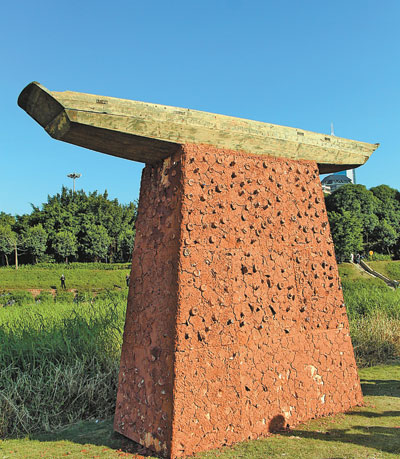|
Cao Zhen
caozhen0806@126.com

THROUGH collaborations with a diverse group of local and international artists, Shenzhen Central Park is bringing to the public a sculpture and installation exhibition in Zone D, south of Hongli Road in Futian District.
Themed “This Time, This Place,” the exhibition uses public space as an outdoor museum, letting works of art “loose in the city, to set them under the light of day where they intrude upon our daily walks and errands,” said Sun Zhenhua, art director of the Shenzhen Public Art Center.
The center curated a public sculpture exhibition last year outside the Civic Center with 12 sculptures. This year’s exhibition integrates with natural surroundings and landscapes in a low-key and organic way, according to Sun.
“Last year, 12 sculptures were created in studios and then moved to the Civic Center; this year, 16 artists were required to make a field study of the park before creating sculptures or installations here,” said Sun.
The well-spaced scenery of the exhibition area along the Futian River in the park offers a natural space for the exhibits. Each exhibit reflects the organic fusion of environmental protection, original creativity, the harmony between people and nature and between nature and art.
“Shenzhen Central Park, separated by the north-to-south Futian River, is like a pair of green lungs in the city. Before the park was open to the public, it was a blooming grove of litchi trees. It’s rare to see a river and a vast greenland in such a dense city. At the exhibition, visitors can touch contemporary art along with grass and trees,” said Sun.
The most striking exhibit is a tree trunk with strings — both sculpture and musical instrument. South Korean artist Ko Seung-hyun made the gayageum, a traditional Korean string instrument, from fallen tree trunks and branches, transforming the bones of a forest into interactive musical instruments that several people can play at once.
“People can play on the gayageum and become part of the artwork,” said artist Zhang Kaiqin at the opening of the exhibition Friday since Ko was not present. “Ko is a nature art sculptor who engages in melting art into the landscape around him. His artwork usually attracts visitors; looking at it should be interesting, comfortable, easy and simple. While other artists put many layers of meanings into their work, Ko wants it simple, so that visitors can touch and experience his work.”
Ko sometimes applies stones, shadows, insects and animals into his artworks. He once said, “Nature art is influenced by nature’s elements. When you go through a river, you follow the stream, the wind comes, the color is changing, you follow the natural cycle and it becomes a natural movement. Nature art generally involves simple interactions with whatever wild creatures and materials the artist finds outdoors.”
The nature art concept can also be found in Shenzhen Public Art Center’s art department’s head Dai Yun’s work. In “Fans Dance in Cool Breeze,” he combines several old Chinese fans together to create a fan tree. When the wind blows, the fans sway to create poetic scenery. Dai said the fans were used in the old days before air-conditioners, so he put the fans in a natural environment to call for an eco-friendly lifestyle.
Sun said that while last year’s artists were all sculptors, this year, they invited some architects and U.S. artist-ethnographer Mary Ann O’Donnell to create art based on their understanding of Shenzhen’s culture and geomorphology.
O’Donnell and her friend Lei Sheng have worked together with a team of artisans from a Shenzhen factory on “Evolution,” an installation of a fishing boat on a mound decorated with beverage bottle caps. Having been in Shenzhen for many years and being now co-director of CZC Special Forces, School of Architecture, Shenzhen University, O’Donnell is doing research on Shenzhen’s urbanized villages and oyster farming.
Lei said villages along the Shenzhen Bay, like Shajing and Houhai, have been farming oysters for 1,000 years, which is a striking feature of local Shenzhen culture. However, with modern industrialization and reclamation, oyster farming is disappearing. “The beverage bottle caps in this work represent modern life and the fishing boat represents the past and the sea. We hope this work helps Shenzheners rethink how to form a sustainable relation with traditional ecological culture.”
The exhibition also has an astonishing array of styles, forms and conceptions, with materials ranging from wooden to steel constructions, to installations made from recycled products. Shenzhen sculptor Yang Guang, for example, installed rafts of used CD-ROMs on the Futian River, a direct reference to the neighboring Huaqiangbei electronics shopping area and the contamination on the river. Hong Kong artist Leung Mee-ping designed a series of fish models installed on a string on the bridge over the Futian River, creating scenery of fishes carefully crossing the river and trying to avoid fishermen.
Dates: Until Jan. 30
Venue: Zone D, Shenzhen Central Park, Hongli Road, Futian District
(福田区红荔路深圳中心公园D区)
Metro: Longgang Line, Lianhua Village Station (莲花村站), Exit B
|

